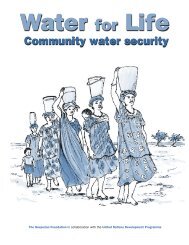A Sourcebook - UN-Water
A Sourcebook - UN-Water
A Sourcebook - UN-Water
You also want an ePaper? Increase the reach of your titles
YUMPU automatically turns print PDFs into web optimized ePapers that Google loves.
Source List 3.1 Country Level Governance Indicators and their Limitations (continued)<br />
Source<br />
World Bank Institute<br />
(2008). “Worldwide<br />
Governance<br />
Indicators”. World<br />
Bank<br />
World Bank and<br />
European Bank<br />
for Reconstruction<br />
and Development,<br />
“Business<br />
Environment<br />
and Enterprise<br />
Performance Survey”<br />
World Bank and<br />
International<br />
Finance Corporation,<br />
“Doing Business” &<br />
“Enterprise Survey”<br />
Description<br />
The World Bank Institute’s Worldwide Governance Indicators report aggregate and individual<br />
governance indicators for 112 countries, based on six dimensions of governance:<br />
voice and accountability, political stability and absence of violence, government effectiveness,<br />
regulatory quality, rule of law, and control of corruption. These are based<br />
on the perceptions or views of enterprises and citizen and expert survey respondents in<br />
both developed and developing countries, and can be useful red flags that corruption<br />
may be occurring. f<br />
The Business Environment and Enterprise Performance Survey (BEEPS), developed jointly<br />
by the World Bank and the European Bank for Reconstruction and Development (EBRD),<br />
is a survey of over 4000 firms in 22 transition countries conducted since 1999–2000 that<br />
examines a wide range of interactions between firms and the state. Based on face-toface<br />
interviews with firm managers and owners, BEEPS is designed to generate comparative<br />
measurements in such areas as corruption, state capture, lobbying, and the<br />
quality of the business environment, which can then be related to specific firm characteristics<br />
and firm performance. g<br />
The “Doing Business” surveys provide objective measures of business regulations and<br />
their enforcement across 178 countries and selected cities at the sub-national level. The<br />
economies are then ranked on the ease of doing business (from 1 to 178, with 1 being<br />
the best). In 2009, both “infrastructure” and “transparency” are expected to be added<br />
as topics. The “Doing Business” results are useful for thinking about corruption risks, since<br />
the red-tape and bureaucratic discretion that make doing business difficult are often<br />
breeding grounds for corruption. h<br />
The World Bank’s “Enterprise Survey” is a similar exercise that analyzes key investment<br />
climate data in emerging markets and provides indicators on the quality of the business<br />
environment. This includes a number of specific indicators of corruption, such as the percentage<br />
of firms expected to offer a payment to get things done, or to secure a government<br />
contract; and percentage of firms who see corruption as a major obstacle for their<br />
business. Fifty-five country profiles are available on the “Enterprise Surveys” website. i<br />
Limitations of country-level indicators<br />
Arndt, C. and<br />
Oman, C. (2006).<br />
“Uses and Abuses<br />
of Governance<br />
Indicators”. OECD<br />
Development Centre<br />
Chapter 4 analyses the World Bank Institute’s World Governance Indicators. It outlines<br />
four core problems with these indicators:<br />
Likelihood of correlation of errors among the 37 sources from which the WGI is constructed<br />
limits its statistical legitimacy<br />
Unable to compare over time<br />
Biased sample<br />
Insufficient transparency.<br />
This paper is available online. j<br />
f<br />
Country indicators can be found here: http://info.worldbank.org/governance/wgi/sc_country.asp<br />
g<br />
You can access the dataset from the BEEPS survey http://info.worldbank.org/governance/beeps<br />
h<br />
Results and rankings are available on the “Doing Business” website: http://www.doingbusiness.org/<br />
i<br />
http://www.enterprisesurveys.org/CountryProfiles/<br />
j<br />
http://www.oecd.org/document/25/0,3343,en_2649_33935_37081881_1_1_1_1,00.html<br />
(continued on next page)<br />
22
















